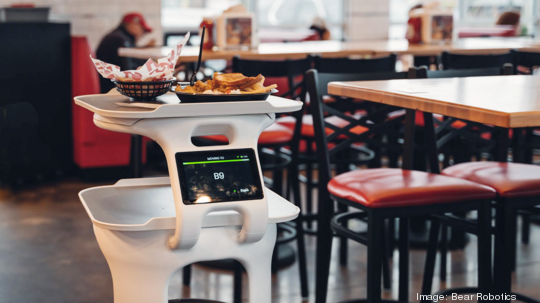
John Ha, a Google developer with a doctorate in computer science, left the tech industry years ago to buy a restaurant but found the grind exhausting. So he started engineering robots to make the restaurant work a bit easier.
Now the Redwood City company he co-founded, Bear Robotics, has shipped out 5,000 autonomous robotic waiters and counts Chili’s, Denny’s and even Google’s own campus cafeteria as customers.
Except to see even more. The company just raised an $81 million Series B round led by IMM Investment and existing investor Cleveland Avenue. It will use the funds to grow its business, launch new robotic products and expand to Europe and Southeast Asia, aiming to capitalize on labor shortages and aging demographics.
Ha's restaurant was Kang Nam Tofu House in Milpitas. It’s still operating today, but Ha left after two years to found Bear Roboti in 2017 along with Juan Higueros and another Google alum, Fangwei Li.
“If you know anything about Korean restaurants, there’s lots of different side dishes so the waiters have to constantly go back and forth delivering them,” said Higueros, the company's CEO. “We wanted to make a tool to do that for them, and we realized this was a problem at every restaurant.”
The company tested its prototype at Amici’s Pizza in Mountain View, and once a complete product was ready, Google's nearby cafeteria became its first customer.
Its flagship Sirvi robot — basically a high-tech tray on wheels — was designed to ease the food running and table busing needs of the restaurant.
The company has shipped out around 5,000 robots to restaurants, casinos, corporate campuses and senior living homes. The robots cost $999 a month as part of a subscription payment model.
“We found the product actually increases tips among waiters and waitresses, on average 25%,” Higueros said. “One partner we have in Miami said it was 28% and saved their waitstaff 25 miles a week in walking around the restaurant.”
He says the robots are meant to help the waitstaff, not replace them, helping them bus tables easier and deliver food, allowing them to handle more tables at once, hence the rise in tips.
However, there are still many people employed solely for the job of food running and busing that might not be so amused by the product.
“Food runners and busboys come and go, sometimes only staying for two weeks, and the restaurants have to constantly be onboarding and training them,” he said. “We want to help the owners of the restaurants too with their staffing shortages.”
The company currently employs almost 200 people and plans to hire more engineers and other staff with the cash influx. It currently operates in 33 states along with South Korea and Japan.
It just signed a deal to expand its robots in up to 100 Chili’s locations and has two new products in the pipeline to be released in the near future.



